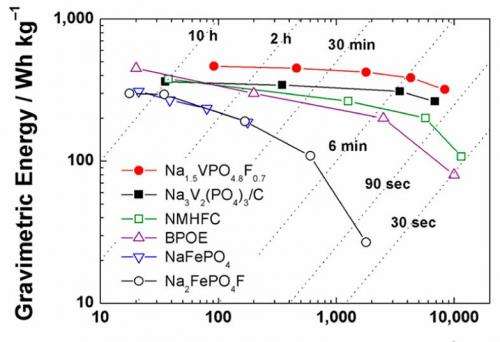This Ragone plot for the new cathode material (red circles) and other cathode materials for Na-ion batteries shows that the new cathode has the highest energy density for a wide range of charge and discharge rates. Credit: Park, et al. ©2013 American Chemical Society
(Phys.org) —Although sodium-ion (Na-ion) batteries don't perform as well as lithium-ion (Li-ion) batteries, they have the potential to be a cheaper alternative. In a new study, scientists have designed a new cathode for Na-ion batteries that provides an energy density of 600 Wh kg-1, which is the highest reported so far for Na-ion batteries and even rivals the energy densities of some Li-ion batteries. The new cathode material also has a greatly improved cycle life, bringing Na-ion batteries a step closer to realization as part of a large-scale energy storage system.
The researchers, Young-Uk Park, et al., from Seoul National University and KAIST, both in South Korea, have published their paper on the new high-energy cathode in a recent issue of the Journal of the American Chemical Society.
As the researchers explain, Na-ion batteries have the potential to meet and even exceed the performance of today's Li-ion batteries.
"The fascinating thing is that Na chemistry is much richer and has more variety than that of Li," coauthor Kisuk Kang, Professor of Materials Science and Engineering at Seoul National University, told Phys.org. "This makes us believe that there will be unexplored Na battery electrodes out there that can far excel the current Li batteries."
Both Na-ion and Li-ion batteries are candidates for being part of a large-scale system that stores energy generated by new technologies, such as solar, wind, and geothermal technology, where energy is produced intermittently. Although Li-ion batteries' high energy densities enable them to store a large amount of energy in a small space, the downsides of these batteries are their high cost and low stability. Since sodium is abundant in the earth, it is much cheaper than lithium, even though Na-ion batteries face their own challenges.
One of these challenges is a low energy density. Until now, the highest energy density of a Na-ion battery has been about 520 WH kg-1. The root of this problem can be traced to the inherent characteristics of sodium (in particular, a less negative redox potential compared to lithium), which reduces the operating voltage and leads to the lower energy density.
Another major challenge for Na-ion batteries is that, even moreso than Li-ion batteries, they suffer from poor long-term stability. This problem also stems from an inherent characteristic of sodium, which is that sodium ions (1.02 Å) are nearly twice as large as lithium ions (0.59 Å). The large size causes a greater change in the host structure upon insertion and removal, which results in a decrease in capacity after repeated cycles.
The new cathode material improves in both areas. The researchers attribute the 600 Wh kg-1 energy density to the cathode material's open crystal framework with vanadium redox couples, which leads to a high voltage that in turn increases the energy density.
The new cathode material also allows the Na-ion battery to retain 95% of its capacity over 100 cycles and 84% for 500 cycles. This outstanding cycle life arises from the fact that the cathode material has the smallest volume change among Na cathodes so far, which is due to the rigid framework that is less sensitive to Na ion insertion and extraction compared to other frameworks.
In the future, the researchers plan to further improve the electrochemical properties of this Na-ion battery cathode with the goal of designing next-generation Na-ion batteries for new applications.
"Further improvements in the cycle stability need to be accomplished in order to be considered for large-scale systems because it requires exceptionally long cycle life (>10 years), unlike small electronic devices," Kang said. "In this respect, not only the electrode stability, but also other aspects such as the compatibility between electrode and the electrolyte, and the electrolyte stability itself, have to be simultaneously considered."
The researchers plan to address these challenges when designing future electrodes.
"We are currently searching for more new electrode materials that can outperform the material that was reported this time," Kang said. "We have both computational and experimental tools to search for them, which will accelerate the identification of this new material."
More information: Young-Uk Park, et al. "A New High-Energy Cathode for a Na-Ion Battery with Ultrahigh Stability." Journal of the American Chemical Society. DOI: 10.1021/ja406016
Journal information: Journal of the American Chemical Society
© 2013 Phys.org. All rights reserved.























